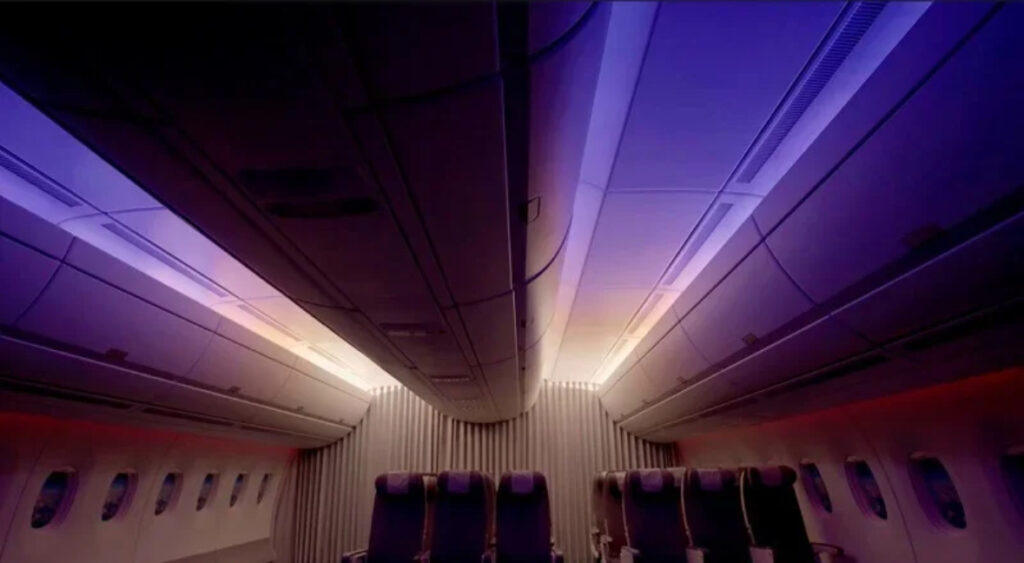For many frequent flyers, the challenge of jet lag is a familiar and frustrating hurdle. The disruption of circadian rhythms, coupled with the stress of air travel, often leaves passengers feeling disoriented and exhausted upon arrival at their destination. Recognizing this, Qantas has taken a significant step towards alleviating these issues by introducing new lighting systems in their cabins. This innovation aims to enhance passenger well-being and reduce the symptoms of jet lag. This article explores the science behind jet lag, the technology Qantas has implemented, and the potential benefits for passengers, positioning this development as a pivotal moment in the evolution of air travel.
Understanding Jet Lag: A Biological Perspective
Jet lag occurs when the body’s internal clock, or circadian rhythm, is out of sync with the local time at the destination. This misalignment is particularly common in long-haul flights that span multiple time zones. The symptoms of jet lag include fatigue, insomnia, irritability, and difficulty concentrating, all of which can significantly impact a traveler’s experience.
The Role of Circadian Rhythms
Circadian rhythms are 24-hour cycles that are part of the body’s internal clock, running in the background to carry out essential functions. These rhythms are influenced by environmental cues such as light and temperature. The most critical cue for regulating circadian rhythms is light. When the body is exposed to light, it signals the brain to suppress melatonin production, a hormone that regulates sleep. Conversely, darkness prompts the production of melatonin, preparing the body for sleep.
Qantas’ Innovative Approach: The New Lighting System
In a bid to combat jet lag, Qantas has integrated a state-of-the-art lighting system across its fleet. This system is designed to simulate natural light patterns, helping to reset passengers’ internal clocks and mitigate the effects of jet lag. Here’s a closer look at how this technology works and its potential impact.
Technology Behind the Lighting System
The new lighting system in Qantas cabins uses a combination of LED lights and advanced software to create a dynamic lighting environment. This system can be programmed to mimic natural light patterns, gradually transitioning between different hues and intensities to align with the time zone of the destination. Key features of the system include:
Dynamic Lighting Control: The lighting adjusts in real-time to simulate sunrise, sunset, and other natural light changes, promoting a smoother transition for passengers.
Personalized Lighting Schedules: Passengers can customize their lighting preferences, enhancing comfort and contributing to better sleep quality.
Reduced Blue Light Exposure: The system minimizes blue light exposure during night-time, which can interfere with melatonin production and disrupt sleep.
The Science Behind the Solution
Qantas’ new lighting system is grounded in extensive research on circadian rhythms and light therapy. Here’s how this technology leverages scientific principles to combat jet lag:
Simulating Natural Light
Research has shown that exposure to bright, natural light during the day helps to reset the body’s internal clock. By mimicking these natural light conditions, Qantas’ lighting system aims to shift passengers’ circadian rhythms, aligning them with the local time at their destination. This approach is based on the concept of light therapy, which has been proven effective in treating circadian rhythm disorders.
Adjusting Light Intensity and Color
The system’s ability to adjust light intensity and color temperature is crucial in regulating melatonin production. For instance, bright, blue-rich light in the morning helps to wake passengers up and promote alertness, while warmer, redder light in the evening encourages relaxation and sleep. This gradual transition helps passengers maintain a natural sleep-wake cycle, reducing the severity of jet lag symptoms.
Implementation and Design: Enhancing the Passenger Experience
Qantas has invested significantly in the design and implementation of this lighting system, ensuring that it enhances the overall passenger experience. Here’s how the system is integrated into the cabin design and its benefits for travelers:
Cabin Design and Comfort
The lighting system is seamlessly integrated into the cabin’s design, with LED fixtures strategically placed to maximize their effectiveness. The lights are designed to be non-intrusive, enhancing the ambiance without overwhelming passengers. Features include:
Mood Lighting: Adjustable lighting options allow passengers to create a comfortable and relaxing environment, whether they are reading, dining, or preparing for sleep.
Intuitive Controls: The lighting system is controlled through an easy-to-use interface, allowing passengers to adjust the settings according to their preferences and needs.
Enhancing Sleep Quality
One of the most significant advantages of Qantas’ new lighting system is its potential to improve sleep quality during flights. By reducing exposure to artificial light and mimicking natural light patterns, the system helps passengers maintain a healthy sleep-wake cycle. Key benefits include:
Improved Sleep Duration and Quality: Passengers are more likely to experience uninterrupted sleep, reducing fatigue and enhancing overall well-being.
Minimized Disruption to Circadian Rhythms: The system’s gradual transition between light settings minimizes the impact on passengers’ internal clocks, promoting a smoother adaptation to the new time zone.
Real-World Impact: Passenger Feedback and Clinical Studies
The effectiveness of Qantas’ lighting system is supported by both passenger feedback and clinical studies. Here’s a closer look at the real-world impact of this innovation:
Passenger Feedback and Satisfaction
Early feedback from passengers has been overwhelmingly positive. Many travelers have reported feeling more refreshed and less fatigued after long-haul flights, attributing these improvements to the new lighting system. Key points of praise include:
Enhanced Comfort: Passengers appreciate the ability to customize their lighting preferences, creating a more comfortable and personalized travel experience.
Better Sleep Quality: Many travelers have noted that they sleep better during flights, waking up feeling more rested and ready to tackle their destination.
Clinical Studies and Research Findings
Clinical studies have further validated the benefits of Qantas’ lighting system. Research conducted in collaboration with sleep scientists and aviation experts has demonstrated that the system effectively reduces jet lag symptoms.
Findings include:
Improved Sleep Patterns: Studies have shown that passengers exposed to the new lighting system experience more consistent sleep patterns, with shorter adjustment periods to the new time zone.
Enhanced Mood and Alertness: The lighting system’s design has been shown to improve mood and cognitive performance, helping passengers stay alert and focused during and after their flights.
Comparative Analysis: Qantas vs. Other Airlines
While Qantas’ new lighting system is groundbreaking, other airlines are also exploring innovative solutions to combat jet lag. Here’s a comparative analysis of Qantas and its peers in the aviation industry:
Singapore Airlines: Innovation in Cabin Comfort
Singapore Airlines has introduced various features aimed at enhancing passenger comfort, including personalized seating and mood lighting. The airline’s focus on creating a restful environment includes:
Mood Lighting and Ambient Music: Singapore Airlines uses mood lighting and soothing music to create a calming atmosphere, helping passengers relax and sleep better.
Wellness Programs: The airline offers wellness programs, including yoga and meditation sessions, to promote passenger well-being during long-haul flights.
Emirates: Pioneering In-Flight Experience
Emirates is renowned for its luxurious in-flight experience, with features designed to enhance passenger comfort and reduce jet lag. Key initiatives include:
Sleep Pods and Suites: Emirates’ first-class suites and sleep pods provide a private, comfortable space for rest, featuring adjustable lighting and ambient noise controls.
In-Flight Entertainment: The airline’s extensive entertainment system includes programs on sleep and relaxation, helping passengers unwind and prepare for sleep.
The Future of Air Travel: Trends and Innovations
Qantas’ new lighting system is part of a broader trend towards enhancing passenger well-being in the aviation industry. Here’s a look at emerging trends and innovations shaping the future of air travel:
Integration of Technology and Wellness
The integration of technology and wellness is becoming increasingly prevalent in air travel. Airlines are adopting various technologies to enhance passenger comfort, including:
Sleep Pods and Ergonomic Seating:Innovations in seating design, such as sleep pods and ergonomic chairs, aim to provide a more comfortable and restful experience.
Wellness Apps and Services: Airlines are partnering with wellness experts to offer in-flight services and apps that promote relaxation, meditation, and sleep hygiene.
Passenger-Centric Design
Sustainability and passenger-centric design are at the forefront of aviation innovation. Airlines are focusing on eco-friendly practices and creating environments that prioritize passenger comfort and well-being. Key initiatives include:
– Sustainable Materials and Practices: Airlines are incorporating sustainable materials and practices into cabin design, reducing environmental impact while enhancing comfort.
– **Personalized Travel Experience:** The use of artificial intelligence and data analytics allows airlines to offer personalized services, tailoring the travel experience to individual preferences and needs.
A New Era in Air Travel
Qantas’ introduction of the new lighting system marks a significant milestone in the quest to reduce jet lag and enhance passenger well-being. By leveraging advanced technology and scientific research, Qantas has created a solution that addresses one of the most pressing challenges in long-haul travel.
The positive feedback from passengers, supported by clinical studies, underscores the effectiveness of this innovation. As the aviation industry continues to evolve, Qantas’ approach sets a new standard for passenger comfort and health, inspiring other airlines to explore similar solutions.
This development not only enhances the flying experience but also represents a step forward in making air travel more enjoyable and sustainable. As we look to the future, the integration of technology, wellness, and sustainability will undoubtedly continue to shape the evolution of air travel, ensuring that the skies remain a place of comfort, relaxation, and possibility for all travelers.
No comments yet.







